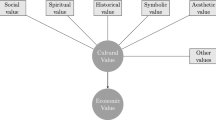Abstract
The cultural atmosphere in a society is accumulated over time through the consumption of cultural services and is diminished through depreciation. Using cultural capital (e.g., cultural heritage, paintings, music scores), cultural services are provided by the cultural-services industry (e.g., museums, opera houses); cultural capital is enlarged by new cultural goods created by individuals. Individuals’ utilities are positively affected by the cultural services they consume, by the cultural goods they create and by the cultural atmosphere and the cultural capital accumulated in society. In a laissez-faire economy, individuals tend to ignore the positive external effects of their cultural-services consumption and creation of cultural goods on other individuals via accumulating cultural atmosphere and cultural capital. Consequently, suboptimally little cultural atmosphere and cultural capital will be accumulated. The efficient intertemporal allocation can be restored by introducing an appropriate subsidy that not only stimulates consumers’ demand for cultural services and the creation of new cultural goods but also enhances the accumulation of cultural atmosphere and cultural capital.

Similar content being viewed by others
Notes
For empirical investigations see, e.g., UNESCO (1998), Part one.
The notion of “artist” is used here as a synonym for “creator of new cultural goods”.
The cultural and technical skills of an individual can be interpreted as creativity in the sense of Throsby (2001, ch. 6).
For convenience of referring to each term of (16) in text, the second line in (16) repeats the first line by assigning [1] = \({\dot{\mu}_g /\left({\delta +\alpha _g} \right)U_r Y_r}\), [2] = (n c U g /U y Y r )/(δ + α g ), etc. This procedure will also be applied in the subsequent equations.
It would also be important, in the first place, to secure the existence of such an equilibrium. We conjecture that an equilibrium can be shown to exist, but a rigorous existence proof is beyond the scope of the present paper.
One may cast into doubt the realism of the remaining Lindahl markets. Yet we defend our procedure on the grounds that in order not to blur the analysis by trying to deal with too many complex allocation problems simultaneously, we have to reduce complexity.
τ k > 0 is a sales subsidy and τ sK < 0 [τ sK > 0] is a subsidy [tax] on the purchase of cultural services.
References
Baumol, W., & Bowen, W. (1966). Performing Arts – The Economic Dilemma. New York: The Twentieth Century Fund.
Blümel, W., Pethig, R., & von dem Hagen, O. (1986). The theory of public goods: A survey of recent issues. Journal of Institutional and Theoretical Economics, 142, 241–309.
Becker, G. (1998). Accounting for tastes. Cambridge: Harvard University Press.
Coleman, J. (1990). Foundation of social theory. Cambridge: Belknap Press.
Frey, B. (2003). Public support. In R. Towse, (Ed.), A handbook of cultural economics. Cheltenham: Edward Elgar.
Fullerton, D. (1992). On justifications for public support of the arts, Journal of Cultural Economics, 16, 67–82.
Heller, W., & Starrett, D. (1976). On the nature of externalities. In S. Lin (Ed.), Theory and measurement of economic externalities. New York: Academic Press.
Lindahl, E. (1919). Die Gerechtigkeit der Besteuerung. Lund, Swenden: Gleerupa Universitats-Boekhandeln.
Netzer, D. (1978). The subsidized muse. Cambridge: Cambridge University Press.
Pethig, R., & Cheng, S. -W. (2002). Cultural capital and the consumption of cultural services. Schmollers Jahrbuch, 122, 445–468.
Robbins, L. (Ed.), (1963). Art and the States. In Politics and Economics. New York: St. Martin’s Press.
Samuelson, P. A. (1954). The pure theory of public expenditure. The Review of Economics and Statistics, 36, 387–389.
Throsby, D. (1999). Cultural capital. Journal of Cultural Economics, 23, 3–12.
Throsby, D. (2001). Economics and culture. Cambridge: Cambridge University Press.
Ulibarri, C. (2000). Rational philanthropy and cultural capital. Journal of Cultural Ecnomics, 24, 135–146.
UNESCO (1998). First World Culture Report. UNESCO, Paris.
Acknowledgements
Helpful comments by Rüdiger Pethig and three anonymous referees are gratefully acknowledged.
Author information
Authors and Affiliations
Corresponding author
Appendices
Appendix A: Derivation of the marginal conditions of Eq. (14)
The FOCs of Eq. (14) are as follows
Appendix B
Derivation of Eq. (15)
Taking (A.5): λ v = λ r /V r , (A.6): λ r = λ y Y r , (A.10): λ y = λ c and (A.11): λ c = U y into account, (A.9): U v + μ g −λ v = 0 can be rearranged to μ g = (U y Y r )/V r −U v , or, equivalently as (15): μ g /(U y Y r ) = 1/V r −U v /(U y Y r ).
Derivation of Eq. (16)
Setting (A.9): μ g = (U y Y r )/V r −U v , (A.1): λ gc = U g_c , (A.2): λ gs = λ s S g , (A.4) and (A.6): λ s = U y Y r /S r into (A.12): \({\dot {\mu}_g =\left({\delta +\alpha _g}\right)\mu _g -n_c \lambda _{gc}-n_s\lambda_{gs}}\), after some rearrangements in terms to get
or, equivalently, Eq. (16).
Appendix C: Derivation of the marginal conditions of Eq. (25)
Appendix D: Derivation of the marginal conditions of Eq. (27)
Appendix E: Derivation of the marginal conditions of Eq. (29)
Appendix F: Derivation of the marginal conditions of Eq. (31)
Appendix G: Derivation of the marginal conditions of Eq. (33)
Rights and permissions
About this article
Cite this article
Cheng, SW. Cultural goods creation, cultural capital formation, provision of cultural services and cultural atmosphere accumulation. J Cult Econ 30, 263–286 (2006). https://doi.org/10.1007/s10824-006-9023-6
Received:
Accepted:
Published:
Issue Date:
DOI: https://doi.org/10.1007/s10824-006-9023-6




